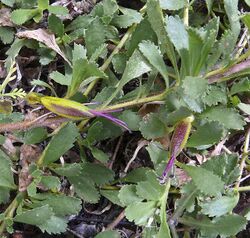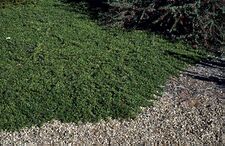Biology:Eremophila biserrata
| Prostrate eremophila | |
|---|---|

| |
| Eremophila biserrata in the Scotia Sanctuary (in NSW) | |
| Scientific classification | |
| Kingdom: | Plantae |
| Clade: | Tracheophytes |
| Clade: | Angiosperms |
| Clade: | Eudicots |
| Clade: | Asterids |
| Order: | Lamiales |
| Family: | Scrophulariaceae |
| Genus: | Eremophila |
| Species: | E. biserrata
|
| Binomial name | |
| Eremophila biserrata Chinnock[1]
| |
Eremophila biserrata, also known as prostrate eremophila, is a flowering plant in the figwort family, Scrophulariaceae and is endemic to a small area in the south of Western Australia. It is a prostrate shrub covering an area of up to about 2 m2 (20 sq ft) and which has serrated leaves and flowers that are green and yellow.
Description
Eremophila biserrata is a prostrate shrub often with long unbranched snake-like stems up to 1 m (3 ft) long and under ideal conditions the plant may spread to a diameter of 4 to 5 m (10 to 20 ft). Its leaves are arranged alternately or clustered in rosettes, mostly 18–24 mm (0.7–0.9 in) long, 5–11 mm (0.2–0.4 in) wide, broadly lance-shaped with the narrower end towards the base. The leaves have serrated edges, the serrations often themselves serrated, sometimes deeply so that the leaf appears to have separate leaflets.[2][3][4]
The flowers are usually borne singly in leaf axils on a stalk usually 3–5 mm (0.1–0.2 in) long but are mostly hidden between the leaves with only the tips of the flowers visible. There are 5 overlapping green sepals differing slightly in size and shape from each other but about 4–5 mm (0.16–0.20 in) long. The 5 petals are 15–20 mm (0.6–0.8 in) long and joined at their lower end to form a tube. The tube and the petal lobes on its end are green and yellow, sometimes pale red and the 4 stamens extend well beyond the petal tube. Flowers appear mostly between September and November and are followed by fruit which are dry, oval-shaped and about 4–5 mm (0.16–0.20 in) long.[2][3]
Taxonomy and naming
Eremophila biserrata was first formally described by Robert Chinnock in 1979 and the description was published in Journal of the Adelaide Botanic Garden. Chinnock collected the type specimen 4 kilometres (2 mi) north of the road between Hyden and Lake Cronin.[5][6] The specific epithet (biserrata) refers to the unusually serrated leaf margins.[2]
Distribution and habitat
This eremophila occurs in areas near Hyden and Lake King[2] in the Coolgardie and Mallee biogeographic regions[7] where it grows in sandy and clay soils near salt lakes and freshwater depressions.[2][8]
Conservation status
Eremophila biserrata is classified as "Priority Four" by the Government of Western Australia Department of Biodiversity, Conservation and Attractions,[7] meaning that it is rare or near threatened.[9]
Use in horticulture
Prostrate eremophila is a ground-hugging shrub, ideal to replace grass where there is no foot traffic, because it does not grow into higher plants. It is easily propagated from cuttings, striking in a few weeks but needs to be kept moist during hot weather when first planted out. It will grow in full sun or as an understorey but is frost tolerant and relatively drought resistant.[4]
References
- ↑ "Eremophila biserrata". Australian Plant Census. https://biodiversity.org.au/nsl/services/apc-format/display/94788. Retrieved 8 April 2020.
- ↑ 2.0 2.1 2.2 2.3 2.4 Chinnock, R.J. (Bob) (2007). Eremophila and allied genera: a monograph of the plant family Myoporaceae (1st ed.). Dural, NSW: Rosenberg. pp. 575–577. ISBN 9781877058165.
- ↑ 3.0 3.1 Brown, Andrew; Buirchell, Bevan (2011). A field guide to the eremophilas of Western Australia (1st ed.). Hamilton Hill, W.A.: Simon Nevill Publications. p. 48. ISBN 9780980348156.
- ↑ 4.0 4.1 Boschen, Norma; Goods, Maree; Wait, Russell (2008). Australia's eremophilas : changing gardens for a changing climate. Melbourne: Bloomings Books. pp. 232–233. ISBN 9781876473655.
- ↑ "Eremophila biserrata". APNI. http://id.biodiversity.org.au/name/apni/94788. Retrieved 23 December 2015.
- ↑ Chinnock, Robert J. (2 April 1979). "Ten new species of Eremophila (Myoporaceae) from Central and Western Australia". Journal of the Adelaide Botanic Garden 1 (4): 252–255. http://www.environment.sa.gov.au/files/assets/public/journal_articles/jabg01p237_chinnock.pdf. Retrieved 23 December 2015.
- ↑ 7.0 7.1 "Eremophila biserrata". FloraBase. Western Australian Government Department of Parks and Wildlife. https://florabase.dpaw.wa.gov.au/browse/profile/7184.
- ↑ Paczkowska, Grazyna; Chapman, Alex R. (2000). The Western Australian flora: a descriptive catalogue. Perth: Wildflower Society of Western Australia. p. 333. ISBN 0646402439.
- ↑ "Conservation codes for Western Australian Flora and Fauna". Government of Western Australia Department of Parks and Wildlife. https://www.dpaw.wa.gov.au/images/documents/plants-animals/threatened-species/Listings/Conservation%20code%20definitions.pdf. Retrieved 23 December 2015.
Wikidata ☰ Q15593252 entry
 |



